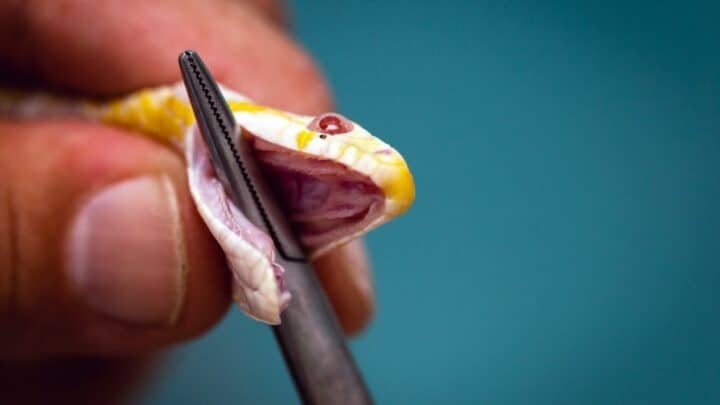The mouths of the majority of snakes have around one hundred tiny teeth. Some snake species have about three hundred teeth, while others have no teeth.
Snakes’ teeth are all the same. It’s how many and what they do with their teeth that should be our concern.
You can’t generally see a snake’s teeth, they are usually all hidden by their gums. In some cases, a few of them pop out.
Rarely will you ever see all their teeth? Plus, how on earth do all those teeth fit in their mouth?
How Many Teeth Do Snakes Have?
Some snake species have no teeth, while other species have anywhere from a hundred teeth to three hundred teeth in multiple rows! While venomous snakes also have fangs, some are retractable and other species have permanent fangs and teeth.
How Many Teeth Snakes Have
The majority of snakes have about 100 teeth. They are small and hidden in the guns. While some snake species have as many as 300 small teeth.
A snake’s teeth are usually always the same size and shape. In other words, their teeth are all the same, in comparison to humans, which are sharper in the front and blunter towards the rear of the mouth.
We’ve previously established that the majority of snakes have around one hundred teeth. Some have considerably more than others, while others have none at all.
In contrast, most snakes possess an excessive number of teeth, leading you to wonder how they fit into their mouths.
Multiple Rows of Teeth
A hundred or more teeth are in a snake’s mouth because they have multiple teeth rows. Like sharks, new teeth fill in the gaps when they fall out or get broken.
When the snake gets hold of its prey, this increases the number of teeth that can grip onto the prey and hold it in place.
Snakes having retractable fangs, on the other hand, do not have the advantage of numerous rows of teeth to work with.
During prey capture and swallowing, snakes utilize their teeth to hold onto and move the prey.
Snakes don’t really consume their food by chewing it. They’re well-known for the way they consume their prey whole.
As a result, they do not chew with their teeth in any capacity. Instead, they utilize them in combination with the strong muscles surrounding their jaw and throat to push their prey down their throats and into their stomachs.
Snakes with No Teeth
Some serpents, such as egg-eating ones, have no teeth whatsoever, whereas others have. This trait’s because they have no use for teeth.
Snakes are all carnivorous, which means they eat meat. There are no instances of herbivore snakes to be found anywhere in nature. However, not all snakes are required to chase their prey.
The egg-eating snake, as the name implies, mostly consumes eggs. Because it doesn’t have to hunt, it does not require teeth.
Instead, it possesses a row of bone spurs connected to its spine within its neck, which serve as a protective barrier.
It makes use of them to assist in breaking the hard shells of the eggs so that it may suck out the insides.
Teeth Differences in Snakes
Most snakes do have teeth, although the shape and size of those teeth can vary greatly.
When it comes to killing methods, the major distinction is between snakes that use venom and snakes that use constriction.
Almost all of the teeth are tiny and can be found deep within the mouth’s interior. You’d have to look more closely and take a long when counting them.
Venomous Snakes
Snakes with venomous bites have teeth that are out of the ordinary. I’m sure you’ve seen the images of vipers or rattlesnakes with their retractable fangs.
However, this isn’t true with all of them. Even among poisonous snakes, there’s a great deal of variety in terms of appearances.
In the first instance, not all poisonous fangs are flexible, and not all fangs are hollow.
The cobra species is an incredible example of both of these characteristics. King cobras, thus named because of their proclivity for devouring other cobras, possess permanent fangs with notches that allow them to inject poison into the prey they are biting.
Cobras with venom-projecting apertures behind their teeth, such as the spitting cobra, use their poison to shock their prey or drive away a predator.
There are 4 types of snake’s teeth in all, with two of them being utilized in combination with venom.
They vary in that one has a permanent fang with grooves on the exterior, while the other has a hollow retractable fang with groves on the inside.
Snakes of each variety have evolved to employ their fangs and venom in a different way throughout the course of time.
Frequently Asked Questions about How Many Teeth Snakes Have
If a snake loses a tooth will it grow back?
Yes, the snake’s teeth and fangs grow back very quickly.
The Last Tooth
Snake teeth are an interesting subject to study. The number of teeth a snake can range from 0 to several hundred, depending of course on the species.
In addition, the kind of teeth and the position of the teeth differ from one another. Some teeth are almost high-tech, with the capacity to retract and hollow interiors that can release poison in a fraction of a second.
Snakes are fascinating reptiles. There are still a lot of scientists who still don’t know about snakes and the evolution of their teeth fall into that category.


